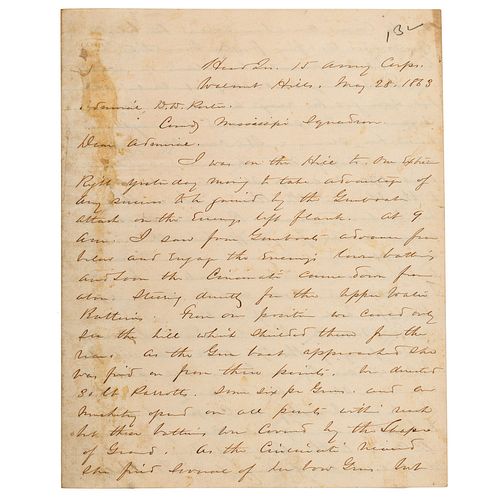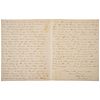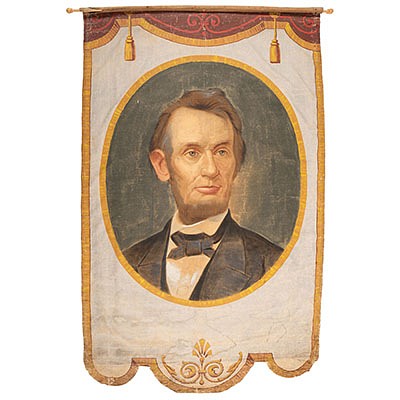SHERMAN, William Tecumseh (1820-1891). Autograph letter signed ("W.T. Sherman Maj. Gen."), as Major General, to Admiral David Dixon Porter (1813-1891)
About Seller
6270 Este Ave.
Cincinnati , OH 45232
United States
With offices in Cincinnati, Cleveland and Denver, Cowan’s holds over 40 auctions each year, with annual sales exceeding $16M. We reach buyers around the globe, and take pride in our reputation for integrity, customer service and great results. A full-service house, Cowan’s Auctions specializes in Am...Read more
Two ways to bid:
- Leave a max absentee bid and the platform will bid on your behalf up to your maximum bid during the live auction.
- Bid live during the auction and your bids will be submitted real-time to the auctioneer.
Bid Increments
| Price | Bid Increment |
|---|---|
| $0 | $25 |
| $500 | $50 |
| $1,000 | $100 |
| $2,000 | $250 |
| $5,000 | $500 |
| $10,000 | $1,000 |
| $20,000 | $2,500 |
| $50,000 | $5,000 |
| $100,000 | $10,000 |
About Auction
Jun 25, 2021
The June 25 American Historical Ephemera and Photography Auction features an exciting assemblage of 18th-early 20th century material, including Civil War archives, Early Photography, Western Americana, Autographs and Manuscripts, and more. Cowan's Auctions dawnie@cowans.com
- Lot Description
Sherman writes to Admiral D.D. Porter, Commander of the Mississippi Squadron during the Vicksburg Campaign. He gives his account of the USS Cincinnati's involvement during the"gunboat attack on the enemy’s left flank" at Fort Pillow, TN: “At 9 am I saw four gunboats advance from below and engage the enemy's lower battery and soon the Cincinnati came down from above. Steering directly for the upper water batteries...As the gunboat approached she was fired on from three points." He continues with details of the Cincinnati's movements: "She ran to the shore and soon sunk...The moment I saw her sink I sent a company of the 76 Ohio to her relief." He reflects on the battle: "The style in which the Cincinnati engaged the Battery elicited universal praise... The importance of the object aimed to be accomplished in my judgment fully warranted the attempt. It has proven unsuccessful and will stimulate us to further efforts to break the Line which terminates on the Mississippi in such formidable Batteries.”
The War Department contracted the Cincinnati to be built in 1861 by James Eads in St. Louis and she was commissioned at Mound City, IL on 16 January 1862 with Lieutenant George M. Bache in command. She was first assigned to duty in the Western Gunboat Flotilla with the Army and participated in the attack and capture of Fort Henry (6 February 1862), operations against Island No. 10 (12 March-7 April 1862), and saw action with the Confederate gunboat fleet at Plum Point Bend and the bombardment of Fort Pillow, described here by Sherman, on 10 May 1862. These operations were instrumental in the Union's gambit of separating Arkansas and Texas from the rest of the Confederacy. After her sinking, she was raised and returned to service under the Navy Department on 1 October 1862.
The Richard B. Cohen Civil War Collection Lots 79-98; 116; 138-153; and 266
Cowan's is pleased to offer the third installment of Richard B. Cohen's collection of Civil War Brown Water Navy photography. Richard was known to many in the field as a "disciplined collector who maintained a relatively narrow focus having built an important, perhaps unsurpassed collection in his area of specialization." From cartes de visite to large format photographs, this portion of the collection features a noteworthy selection of images of Brown Water Navy warships, among them, the USS Benton, Choctaw, Lafayette, and Louisville. Many important identified naval officers are also represented, including an exquisite CDV of the promising young officer, Lieutenant Commander William Gwin, who died of wounds aboard the USS Benton following an artillery duel with Confederate forces at Snyder's Bluff, and an exceptionally large war-date photograph of the controversial commander of the USS Pittsburgh, Egbert Thompson.
This auction also features a premiere selection of autographs and manuscripts from Richard's carefully curated collection. Highlights include a letter from Jefferson Davis to his distant cousin, John J. Pettus, Governor of Mississippi, dated a year before secession, conveying intricate plans for securing armaments in preparation for the war; an Abraham Lincoln signed endorsement; a letter from Admiral D.G. Farragut from New Orleans, offering excellent insight into his "political" thinking as well as his dedication to his work; correspondence from Gideon Welles, David Dixon Porter, U.S. Grant, and W.T. Sherman; and a pair of superb letters with highly descriptive accounts of the Battle of the Monitor and Merrimac.
Provenance: The Richard B. Cohen Civil War Collection - Shipping Info
-
SHIPPING & PICKUPS Cowan’s Cincinnati Office offers an in-house, full-service shipping department which is unparalleled in the auction industry. Shipping costs are provided with your finalized invoice 24-48 hours after auction. For furniture and oversized items, we recommend using third-party services. For more information, contact cowansshipping@hindmanauctions.com. NOTE: All pickups and preview are by appointment only. To make an appointment, please call 513-871-1670 or email cincinnati@hindmanauctions.com Buyers are required to pay for all packing, shipping and insurance charges. Overseas duty charges are the responsibility of the successful Bidder. Be aware that for larger and/or valuable items, shipping charges can be substantial. - Shipping charges include insurance for your order while in transit. If you have private insurance we will adjust your charge to include only packing and shipping. - Please allow 14 – 21 days after payment to package and ship your purchase as carefully as possible.
-
- Buyer's Premium



 EUR
EUR CAD
CAD AUD
AUD GBP
GBP MXN
MXN HKD
HKD CNY
CNY MYR
MYR SEK
SEK SGD
SGD CHF
CHF THB
THB












